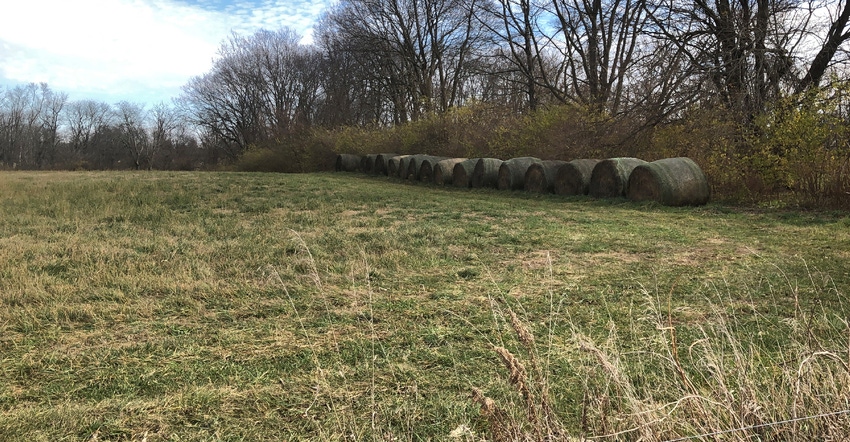
There is good news and bad news when it comes to the winter 2020-21 hay assessment. The consensus is that lots of hay was made in 2020, and much of it is good. The not-so-good news is that most producers started feeding hay earlier than normal.
“It will likely balance out and there will be enough hay to get Indiana cattlemen through the winter, although some of it may change hands before spring arrives,” says Chris Parker, Morgantown, Ind. Parker is a forage producer with a small cow-calf herd. He also is a retired Purdue University Extension educator.
“Most of the state had great weather for making first-cutting hay,” he says. “There was plenty of moisture to produce good growth. Then it dried out in time to make hay. Many areas caught rains and had good second and third cuttings of alfalfa-grass hay.
“The problem was, it went so dry in later summer and early fall that many people, including me, were forced to begin offering hay up to a couple months earlier than normal. Pastures just dried up, and cattle ran out of forage.”
The trick now, Parker says, is to know what quality hay you have, and feed your lower-quality hay first while cows have lower needs for energy and protein. Save your best-quality hay for closer to when cows reach the end of pregnancy and begin lactating.
If you baled cornstalks or plan to run cows on stalks, make use of it as soon as possible, Parker advises.
“The most feeding value is in the grain, husks and leaves,” he explains. “Modern combines don’t leave that much grain, and what is left deteriorates quickly. Nutrients leach out of husks and leaves quickly too. The longer into winter you hold it, the less quality it will have.”
In his small operation, Parker stacks big round bales in his storage area by cutting. He feeds first-cutting hay first because he knows it’s generally more mature, simply because it’s difficult to cut first-cutting hay early in Indiana due to the weather. He saves later cuttings to feed closer to when cows near the end of pregnancy. Second and third cuttings tend to run higher in protein and total digestible nutrients, especially if made when the legume was just starting to bloom, he notes.
“As a general rule, the more mature plants are before cutting, the higher the fiber, lower the TDN and lower the protein levels,” he says. “By the same token, alfalfa-orchardgrass mixes compared to straight grass hay tend to be higher in TDN, lower in fiber and higher in protein. If you have some bales of both, feed the grass hay earlier when the cow’s requirements are lower.”
If you haven’t tested forages lately and aren’t confident about TDN and protein levels in your forage, Parker recommends pulling hay samples on each lot of hay. “It’s simple to do and relatively inexpensive,” he says. “Then you’re not guessing as to which hay is better, or as to how much supplement you should offer when feeding each type of hay.”
Most county Extension offices in Indiana have a Penn State-type forage sampler available for loan. Coupled with an electric drill, you can pull cores of a sample quickly and easily.
About the Author(s)
You May Also Like




